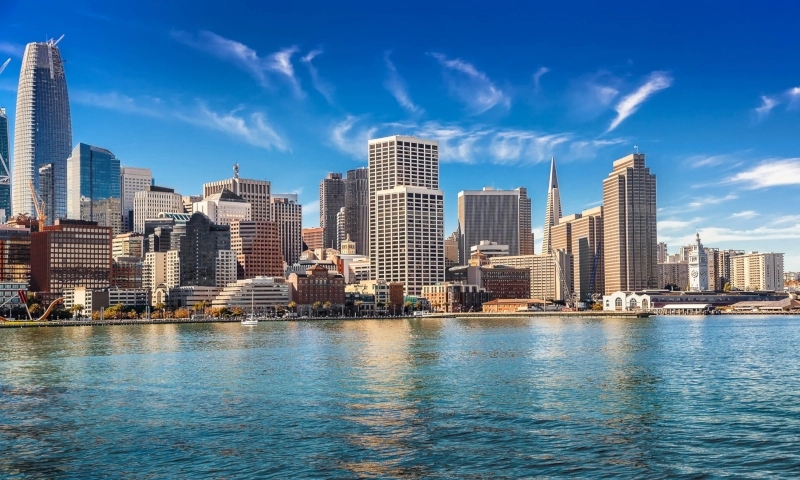An architectural challenge facing many cities in the US is how best to convert commercial office buildings into housing. Some might wonder why conversions of empty office buildings aren’t happening faster. Cities like San Francisco face a lack of affordable housing and a growing homeless population. The same is true even for smaller cities like Marin’s San Rafael.
How serious is the problem nationwide?
News stories abound with examples of both the significantly high commercial vacancy rates for big cities and the fabulous makeovers of once-famous commercial skyscrapers converted to luxury living spaces. Take Chicago’s Tribune Tower, built in the Gothic Revival architectural style in 1925 through the efforts of architects Raymond Hood, John Mead Howells, John Vinci and Edward J. Burling. The conversion to ultra-luxury apartments was completed in 2021 by the architect Solomon Cordwell Buenz.
Of course, San Francisco has its 100 Van Ness skyscraper, built in the 1970s, which housed the California State Automobile Association. This building was also converted into luxury apartments. But these two conversions were very different. The former was a much-loved National Historic Landmark building that painstakingly preserved exterior architectural elements. The San Francisco skyscraper’s transformation included reskinning the building to remove exterior concrete, replaced with glass, for stunning floor to ceiling views.
The natural question might be, why aren’t more of these conversions taking place? After all, according to an opinion piece in the Washington Post, the commercial vacancy rates are high in many major US cities and the demand for housing in urban areas is equally great.
Yet, as the chart in the article reveals, the conversion rate hovers in the low single digits, aside from the city of Cleveland.
What is the solution?
According to a recent working paper from the National Bureau of Economic Research (NBER):
“The conversion of brown office buildings to green apartments can contribute towards a solution to three pressing issues: oversupply of office in a hybrid-and-remote-work world, shortage of housing, and excessive greenhouse gas emissions.…We present a pro-forma real estate model that identifies parameters under which these conversions are financially viable. We highlight several policy levers available to federal, state, and local governments that could accelerate the conversion, and that may be necessary should policymakers desire the creation of affordable housing. We highlight the role that the Inflation Reduction Act could play.” (© 2023 by Arpit Gupta, Candy Martinez, and Stijn Van Nieuwerburgh.)
One of the major challenges is the economic viability of these conversions. After all, the buildings were not designed for residential use. While that might not sound like an insurmountable issue, the difference in basic design realities requires that buildings be evaluated for their convertibility.
What are the barriers?
Baseline cost of the building
As noted in both the Washington Post opinion piece and the NBER working paper, the actual cost of the commercial buildings can be a challenge. Even with the reduction in market-rate value of a commercial property, the cost may still be prohibitive. Add to that the fact that the building owner(s) may hold on to the hope the commercial market will turn around, costs for the foreseeable future remain out of reach of affordable housing proponents. That is why many of the examples of the conversions focus on luxury or ultra-luxury apartments.
Complexity of the renovations
The electrical and plumbing configurations can be quite different in commercial buildings when compared that of residential needs. Those changes may require the addition of electrical or plumbing systems that may need to go into the ceiling area. The regulations for ceiling height require seven feet of clearance.
Also, window placement can be a problem. Imagine a very large, wide open office area with windows along the outside. Cubicles work on that open floor plan, but what happens when that open area is sliced into individual rooms. The ones closer to the center won’t have windows at all.
Too many rules and a lack of incentives
Even when the price is right and a building has the correct structure and window placements to accommodate a conversion, it still might not happen. Besides the cost and logistics of physical renovations, conversions face the barriers of zoning and housing regulations.
Good news on the horizon
The doom-and-gloom scenario for downtown and industrial areas of big cities may be changing. An opinion piece by the Los Angeles Times editorial board pointed to the fact that local and state government entities are working to ease the land-use laws so developers can make the conversions. They point to the fact that AB-2011 Affordable Housing and High Road Jobs Act of 2022, which took effect July 1, 2023, fast-tracks approval of 100% affordable housing, which includes conversions.
What is happening locally?
The City of San Rafael has an example of a successful conversion-in-progress in the Canal neighborhood. The former office building at 3301 Kerner Boulevard is currently under renovation to complete a supportive housing complex for homeless individuals. The project is a partnership between the City of San Rafael, the County of Marin and Eden Housing, a nonprofit developer and property management company.
Another conversion/reconstruction mixed-use project is in the planning stages for the Northgate Shopping Center in Terra Linda to provide retail with market-rate and below-market-rate housing.
Creative architectural designs and ideas will ensure that more projects like these can bring much needed affordable housing options to Marin and the Bay Area.


